Linlithgow
Linlithgow (/lɪnˈlɪθɡoʊ/ lin-LITH-goh; Scots: Lithgae; Scottish Gaelic: Gleann Iucha) is a town in West Lothian, Scotland. It was historically West Lothian's county town, reflected in the county's historical name of Linlithgowshire. An ancient town, it lies in the Central Belt on a historic route between Edinburgh and Falkirk beside Linlithgow Loch. The town is situated approximately 20 miles (32 km) west of Edinburgh.
Linlithgow
| |
|---|---|
| Town | |
 Linlithgow Town Centre, showing the Burgh Halls (background) and the Cross Well (foreground), August 2018 | |
 Linlithgow Location within West Lothian | |
| Population | 12,840 (mid-2020 est.)[3] |
| OS grid reference | NS996774 |
| Council area | |
| Lieutenancy area | |
| Country | Scotland |
| Sovereign state | United Kingdom |
| Post town | LINLITHGOW |
| Postcode district | EH49 |
| Dialling code | 01506 |
| Police | Scotland |
| Fire | Scottish |
| Ambulance | Scottish |
| UK Parliament | |
| Scottish Parliament | |
During the medieval period, the town grew in prominence as a royal burgh and residence around Linlithgow Palace. In later centuries, Linlithgow became a centre of industry in leather making and other materials, before developing rapidly in the Victorian era with the opening of the Union Canal in the 1820s and the arrival of the railway in 1842. Linlithgow was the former county town of the county but the Council now resides in nearby Livingston. Today Linlithgow has less industry and the economy of the town centre is focused on hospitality, heritage and tourism services. Linlithgow's patron saint is Saint Michael and its motto is St. Michael is kind to strangers. A statue of the saint holding the burgh coat of arms stands on the High Street. In 2019, the population of the Linlithgow ward (which includes the town and greater area) was 16,499.[4]
History
Etymology
The name Linlithgow comes from the Old Welsh lynn llaith cau meaning "lake in the moist hollow".[5] Originally "Linlithgow" referred to the loch itself, the town being known as just "Lithgow" (hence the common surname).[5] Folk etymology associated this name with the Gaelic liath-chù meaning "grey dog", likely the origin of the black bitch on the burgh arms.[5] Evidence of Bronze Age and Iron Age settlements has been found around Linlithgow, in the form of Crannogs in Linlithgow Loch.
Medieval history
Linlithgow gained its royal status as a burgh in 1388 under a charter from Robert II of Scotland.[6] Linlithgow developed in the Middle Ages as a royal residence for Scottish Kings on the raised hill beside the Loch, as the site was a logical stop between Edinburgh to the east and Stirling to the West.[7] Linlithgow Palace remains the chief historic attraction of the town. The present palace was started (on an older site) in 1424 by James I of Scotland. It was attacked by Oliver Cromwell in 1650 and later burnt in 1746,[8] and, whilst unroofed, it is still largely complete in terms of its apartments, though very few of the original furnishings survived. The palace was the birthplace of James V and Mary, Queen of Scots, and has been described as Scotland's finest surviving late medieval secular building.[9] In the courtyard of the Palace, an elaborately carved hexagonal fountain and well survives.[10]
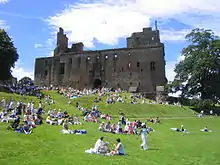
Besides the palace, a second attraction, standing adjacent, is the primarily 15th century construction of St. Michael's Church. Its western tower originally had a distinctive stone crown spire, of the type seen also on St Giles Cathedral in Edinburgh, and Newcastle Cathedral, but it was damaged in a storm in 1768 then removed in 1821.[11] In 1964 a controversial replacement spire in aluminium in a modern style by Geoffrey Clarke, representing Christ's crown of thorns, was added to the tower.[12][13][14] The church was used in the early 17th century as host for the General Assembly of the Church of Scotland and one of the national covenants was signed within.[10] The church was extensively altered and renovated in the 19th century, with James Gillespie Graham demolishing the chancel arch and added fake-masonry plaster vaults, and then later Honeyman and Keppie rebuilding the chancel arch and added a choir vestry.[12]
A Carmelite Friary was located in the southern part of town from the 13th century until 1559, when it was destroyed during the Scottish Reformation.[15] The grounds of the friary are split between a public park (Rosemount Park and Friar's Well) and a private woodland (Rosemount woods) and estate, occupied by a 19th-century villa, Nether Parkley.[16][17]
The first murder using a firearm in Scotland took place in the High Street of the town on 23 January 1570 when James Stewart, 1st Earl of Moray was assassinated by James Hamilton of Bothwellhaugh, a supporter of Queen Mary.[18] As Moray was passing in a cavalcade in the main street below, Hamilton fatally wounded him with a carbine shot from a window of his uncle Archbishop Hamilton's house.[19]
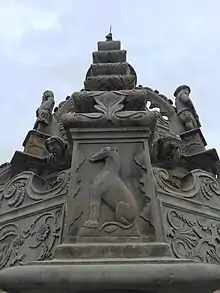
Many historic buildings line the High Street that follows the original route from the East (High and Low Ports) and West (Ports) Gates.[20] On the south side, ground levels rise and several historic wynds and closes, as found in Edinburgh, still exist. The most prominent historical space is the Kirkgate, a processional route to the palace from the High Street.[20][21] This contains the Cross Well of 1807 (redesigned by James Haldane[22]) which is said to be replica of its 1628 predecessor.[23]
North of the well stands the former civic home of the Burgh Council, the Town House of 1668 which was created under the direction of the master mason John Smith and now forms part of the complex known as the Burgh Halls.[24] This replaced a previous hall or Tolbooth demolished by Oliver Cromwell's army in 1650. Much of its original interior was removed in a modernisation project of 1962.[25] In June 1622 Katherine Rannald (alias Broun) from Kilpunt and her daughter Barbara Home (alias Winzet) were imprisoned in the Tolbooth on suspicion of witchcraft.[26]
Linlithgow was also the site of the Battle of Linlithgow Bridge at the western edge of the town. The bridge no longer stands. The roadway to Linlithgow over the River Avon is described by scholars as a lifted road.
By 1799, Linlithgow was described as a large town with about 2300 inhabitants, whose primary industries included the tanning of leather, refining cotton cloth, the making of Tambour lace and Stockings, and shoemaking, as well as acting as a market town for the surrounding agriculture.[27] From the 17th until the late 19th century, the two largest industries in Linlithgow were leathermaking and shoemaking.[28]
Modern history
.jpg.webp)
In 1847, a pharmacist in the town, David Waldie is credited as being the first to produce a sample of chloroform for medical use, presenting it to James Young Simpson who later tested it and had it produced again on his return to Edinburgh, popularising its use as an anesthetic in medicine.[29][30][31] In the mid 20th century, the chemists became a restaurant and is now the Four Mary's pub (a plaque records the history).[32]
In December 1887 a new events venue was completed in a castle style with turrets and named the Victoria Hall.[29] In 1956, the Hall was sold for use as a Ritz cinema and later was used as a theatre, before falling out of use in the 21st century and subsequently being demolished, despite a public effort to save the facade.[33][34] Other prominent Victorian buildings in the town include the turreted Royal Bank (erected in 1959), the Star And Garter Hotel (converted in 1847) and the Scots revival styled St. Michael's Hotel (1886).[35][36][37]
Animal glue was produced at the Gowanstanks works for many years, on the site now occupied by St. Josephs primary school.[32] Linlithgow has been cited as the location of the first petrol pump in Scotland.[38] A plaque on the High Street records that Scotland's first petrol pump was installed at a garage here in 1919. In 1940, the Neo-Georgian County Buildings were completed in the town and became the home of Linlithgowshire Council.[39][40] They were later renamed as the Tam Dalyell House and are now the Linlithgow Partnership Centre, home to the town library and museum.[41]
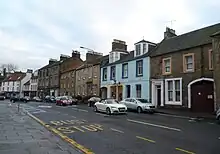
In 1967, two large tracts of land on the northern side of the High Street (with their associated pre 19th century buildings) were demolished and replaced by 90 flats, garages and public buildings (including a library and health centre) in a brutalist style project named the 'Vennel redevelopment'.[42][43] The name Vennel coming from the term for a passageway between the gables of two buildings. While the development won a Saltire Housing award in 1969, it was and still remains controversial, especially as the style contrasts starkly with the character of other buildings in the town and significantly altered the street layout.[42][44] After many decades of discussion, the partial demolition and redevelopment of the Vennel area was agreed by West Lothian Council, subject to consultation, which began in 2021.[45][46][44][47]
The town has continued to grow, not only because of its transport links with Edinburgh, Glasgow and Stirling, but also because of the perceived quality of its schooling and local amenities. The town grew considerably during the 1990s with the completion of several housing developments on the east side of the town. Development in the town is carefully controlled, as it is now bounded by green belt to the south and east, the M9 to the north, the river Avon and county boundary to the West.
Following the formation of the Territorial Force the town was allocated, for recruiting, to the Lothians and Border Horse and 10th Battalion, Royal Scots. Today 1 SCOTS recruit from the area keeping the traditions of the area from the Royal Scots.[48]
Geography

Linlithgow is located in the north-east of West Lothian, close to the border with the Falkirk Council area (historically part of Stirlingshire). It lies 20 miles (32 km) west of Edinburgh along the main railway route to Glasgow. Before the construction of the M8 and M9 motorways and the opening of the Forth Road Bridge, the town lay on the main road from Edinburgh to Stirling, Perth and Inverness, while the canal system linked the burgh to Edinburgh and Glasgow. The nearby village of Blackness once served as the burgh's port. Linlithgow is overlooked by its local hill, Cockleroi.
The town has a generally east–west orientation and is centred on what used to be the main Edinburgh-Stirling road; this now forms the main thoroughfare called the High Street. Plots of farmed land, known as rigs, ran perpendicular to the High Street and comprised much of the town's development until the 19th century. Growth was restricted to the north by Linlithgow Loch, and by the steep hill to the south, but, in the late 19th and early 20th centuries, development began much further south of the High Street. In the late 20th century, demand for housing led to many residential developments much further south, as well as spreading into new areas. This southward development was bisected by the Union Canal and latterly by the main Edinburgh-Glasgow railway line, and today there are traffic problems because there are only three places in the town where each of these can be crossed.
To the west, Linlithgow Bridge used to be a somewhat distinct village with its own identity, but in the latter half of the 20th century it was enveloped in the expansion of the main town. Today the distinction between them is hard to make out.
Governance
UK Parliament
In the Parliament of the United Kingdom at Westminster, Linlithgow has been represented as part of the Linlithgow and East Falkirk constituency since 2005. Linlithgow was a safe Labour seat until the 2015 when sitting MP Michael Connarty was defeated by Martyn Day of the SNP. Day remains the MP having successfully defended the seat at the 2017 and 2019 elections.
Scottish Parliament
In the Scottish Parliament, Linlithgow is represented by the SNP's Fiona Hyslop, the Cabinet Secretary for Culture, Tourism and External Affairs. Prior to the 2011 Scottish Parliament election, the town was represented by Mary Mulligan of Labour. It is also part of the Lothian electoral region, which elected 3 Conservative, 2 Labour and 2 Green MSPs under the additional member system in 2016.
Council
At the county level, Linlithgow is represented locally under West Lothian Council. In both the 2012 and 2017 local elections, Linlithgow ward elected one Conservative, one Labour and one SNP councillor. In the 2022, Linlithgow ward elected one SNP, one Labour and one Liberal Democrat councillor, namely Pauline Orr, Tom Conn and Sally Pattle, respectively. 2022 was the first election which saw Linlithgow ward elect any female councillors to West Lothian Council.
At the local level, the Linlithgow and Linlithgow Bridge Community Council is the local Community council.[49]
Coat of arms

The burgh's coat of arms features a black bitch chained to an oak tree on an island, and those born within the town are known as "black bitches".[50] In his account of a tour of Scotland, published in 1679, an English gentleman, Thomas Kirk, described the arms of the town as "a black bitch tied to a tree, in a floating island. We enquired for a story about it, but could meet with none: their schoolmaster told us it proceeded from the name of the place. Linlithgow, in Erst [Gaelic], is thus explained: Lin signifies Lough; Lith, black; and Gow, a hound."[51]
A more recently recorded legend relates that the bitch was a black greyhound whose master was sentenced to starve to death on an island in the loch. She used to swim from the town every day with food for him. When this was discovered she was chained to a tree on a different island to suffer the same fate as her master. The townspeople took the animal's loyalty and bravery as symbolic of their own.
Economy
Linlithgow's rich history and central location make it a popular tourist destination, while many local people commute to Glasgow, Edinburgh or Stirling; this is made relatively easy by the town's railway station and its proximity to both the M8 and M9 motorways.
The town is served by three supermarkets and a retail park situated in Linlithgow Bridge. There are also a diverse range of local retailers in the High Street. In 2012, there were controversial proposals for a new retail and housing development to the east of the town which were opposed by several local groups.[52][53] However, in November 2013, the planning application was rejected due to the effect it would have on the towns character.[54]

Linlithgow is home to a major computing centre owned by Oracle and to the telecommunication company Calnex Solutions, founded in 2006 in the town and which floated on the AIM market in September 2020.[55][56]
Former industries include the St. Magdalene's distillery, the Nobel explosives works, paper mills and many tanneries. The Regent Centre, now known as Nobel House, replaced the previous 1908 build Nobel Explosive Company Works Factory in 1983 and is home to a small shopping centre, with several shops and a bank.[57]
Culture and community
The Riding of the Marches, held in one form or another since the mid-16th century and nowadays celebrated on the first Tuesday after the second Thursday in June, involves young and old in the tradition of checking the burgh's perimeter, including the town's historic port of Blackness. Although today's activities are centred more on the colourful parades through the town that involve bands and floats decorated by local groups, the more ceremonial duties of the Marches are still performed, and a variety of local groups ensure that the traditions, old and new, are maintained.[58]
There are many other events during the year such as the Children's Gala Day,[59] the Linlithgow Folk Festival and a pre-Christmas Victorian Street Fayre, and since 2014, Party at the Palace which is a music festival held annually in August by the loch and has brought acts including Nile Rodgers, Kaiser Chiefs, Travis, Simple Minds, The Proclaimers, Texas and many others to play in the town. The Charlatans and Deacon Blue headlined Party at the Palace 2019. The sense of community is enhanced by many active local groups such as Linlithgow Amateur Musical Productions (LAMP),[60] Lithca Lore, the Linlithgow Players[61] and the 41 Club. The town also has its own weekly local newspaper, the Linlithgow Gazette.[62]
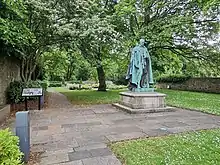
The Linlithgow Union Canal Society runs a canal museum and operates narrowboat tours from Manse Road basin.[63]
The town has two Church of Scotland parish churches: St Michael's and the smaller St. Ninian's Craigmailen. There are also churches of other denominations, including a Methodist chapel (now an evangelical church, St. John's, which meets in Linlithgow Academy on a Sunday morning); St Peter's, an architecturally distinctive Scottish Episcopal church; and a Roman Catholic church, also called St Michael's, which was used as an ambulance depot by Polish servicemen during the Second World War.[64]
The Linlithgow Museum is a volunteer-run local history museum in Linlithgow.[65][66] The museum is housed in the Linlithgow Partnership Centre, along with the West Lothian Family History Society and library.[67]
St Michael's is a community hospital in the town, operated by NHS Lothian.[68] The hospital has its origins in the Linlithgow Combination Poorhouse and Infirmary which opened on the site in 1856.[69] An infectious diseases hospital was built on an adjacent site in around 1900.[69] The poorhouse infirmary and the infectious diseases hospital came together to form St Michael's Home and Hospital in 1932.[69] The combined facility joined the National Health Service in 1948.[69] The poorhouse building was demolished in 1969 and replaced with the current modern facility.[69]
A local pub and hotel on West Port named "The Black Bitch" (after the town's coat of arms) is reputed to be one of Scotland's oldest pubs[70] although much of the building is recorded as dating to the 18th century.[71] In early December 2021, the pub's owners, the Greene King chain, announced plans to change the name of the pub to "The Black Hound" on the basis that the original name had "racist and offensive connotations". The change was opposed by some local residents, who started a petition to retain the old name.[72][73][74][75] By mid-December 2021, the petition had received over 10,000 signatures and had also resulted in a local demonstration.[76] However, in February 2022, Greene King confirmed that a name change to "The Willow Tree" would take place.[77]
Parks
Linlithgow has several parks and recreation grounds across the town. The largest public area is the Peel and Palace Royal Park beside Linlithgow Loch and palace, including a large open grassland (the Peel), a circulatory walk around the Loch and mature trees to the south.[78][79]
Linlithgow Rose Garden is a mature rose garden in the area adjacent to the Kirk grave yard and the rear of the Burgh Halls and contains a large bronze statue of John Hope, 7th Earl of Hopetoun and Marquess of Linlithgow (created in 1911).[80] As of 2021, the rose gardens are in the process of being improved.[81]
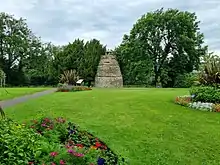
Learmonth Gardens is located on the south side of the railway across from the canal basin and were given to Linlithgow in 1916 in memory of Alexander Learmonth, who was Provost of Linlithgow from 1802 to 1807.[82][83] The key feature of the gardens is a 16th-century beehive type doocot that was originally part of the tail of a run rig from the house of Baron Ross of Halkhead on the High Street (the rig was split when the railway was created in 1842).[82][83] The doocot has 370 nest boxes in 18 tiers and a lantern on the top although access inside is closed.[82][83]
Rosemount Park is a large open public park in the centre of southern Linlithgow containing a Friar's Well.[17] The well originally provided water for the former carmelite priory, destroyed during the Scottish Reformation and is now covered with a stone arch.[17] The park contains several mature trees.[84]
Kettlestoun Mains is a woodland walk beside the Avon Lagoon and near the former site of the Battle of Linlithgow Bridge.[85] Just outside of Linlithgow, there are several country parks, including Beecraigs Country Park (a 370 hectare park between Bathgate and Linlithgow with forests, a visitor centre and a loch)[86] and Muiravonside Country Park between Linlithgow and Torphichen (170 acres of woodland and grassland).[87]
Transport
Linlithgow railway station is the main railway station serving the town and is located on the Glasgow to Edinburgh via Falkirk Line. It is served by ScotRail services from Edinburgh Waverley to Dunblane, and the daily train between Glasgow Queen Street and the Fife Circle Line. The station opened on 21 February 1842.[88] The M9 Motorway is located on the northern outskirts of the town, connecting Linlithgow with Edinburgh, Stirling and Falking via motorway. The main east/west road through the town is the A803 road, part of which is the High St of Linlithgow. The main north/south road through the town is the A706 road. The nearest airport is Edinburgh Airport.
Linlithgow is served by McGill's Scotland East bus service X38 between Edinburgh and Falkirk via Corstorphine, Kirkliston & Winchburgh. Linlithgow used to be served by Lothian Country services X38 & EX2, these were suspended in March 2020 and later withdrawn.
Education

Linlithgow has one Secondary school: Linlithgow Academy.[89] The original Linlithgow Academy was housed in a purpose build sandstone building in East Port, designed in a Scots renaissance style with turrets by James Graham Fairley in 1900.[57] The Academy moved to a new school complex on Braehead Road in 1968 towards the south-west of the town and the old academy buildings are now home to Low Port Primary School.[90][91]
The town has five primary schools: Linlithgow Primary School, St Joseph's RC Primary School, Linlithgow Bridge Primary School, Low Port Primary School and Springfield Primary School.[92]
Donaldson's School, Scotland's national school for the deaf, is based in the town, having relocated from Edinburgh to a new campus (the Sensational Learning Centre) in Linlithgow in 2008, designed by JM Architects.[93][94][95] The school was built on the site of a former Signetics electronics factory that had opened in 1969 during the Silicon Glen period of development, which itself was built on an earlier Racal factory that produced defence radars and displays.[96]
Linlithgow does not have a college in the town. The nearest colleges are West Lothian College in Livingston and Forth Valley College in Falkirk.
Sports
.JPG.webp)
Linlithgow Rose Community Football Club (formed from a partnership of Linlithgow Rose Football Club and BFC Linlithgow) has about 500 player members,[97] involved in soccer 4s, soccer 7s, girls, youth and adult junior football. The club has a dedicated goalkeeping school and referee training programme and has been awarded Community Level status in both the SFA Quality Mark and West Lothian Council Club Accreditation schemes.
Linlithgow is also host to Linlithgow Rose F.C.,[98] Linlithgow Rugby Football Club as well as Linlithgow Cricket Club[99] who play at the Boghall Cricket Club Ground. Linlithgow also hosts two main registered Scotland Supporters Clubs for the Scottish National football team: Linlithgow & District Tartan Army (LADTA) and the Young Linlithgow Tartan Army (YLTA).
A number of local parks, including play areas for children, are spread throughout the burgh, with the tract of land surrounding the palace known as the Peel being particularly popular in summer. Low Port Outdoor Education Centre[100] is situated next to the loch and provides facilities for many outdoor activities, many based on the adjacent loch. Nearby country parks include Beecraigs and Muiravonside.
Linlithgow golf club, founded in 1913, sits to the south of the canal on the western edge of town.
Notable people
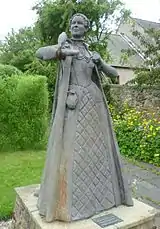
Scottish monarchs born in the town include King James V, born in Linlithgow Palace in 1512, and Mary, Queen of Scots, born and christened in Linlithgow in 1542.
Historical figures in trade, science and industry from Linlithgow include Sir Charles Wyville Thomson, natural historian, marine zoologist and chief scientist on the Challenger Expedition), John West, Captain (1809–1888, was a Scottish inventor and businessman who emigrated to Canada, California and later Oregon where he operated a cannery and exported tuna to Great Britain), David Waldie (a local chemist who recommended the use of chloroform in medical use to Sir James Young Simpson[32]) and Sir Thomas Carlaw Martin (1850-1920, a newspaper editor and Director of the Royal Scottish Museum).
Sports figures include Colin Fleming (a professional tennis player was brought up and educated in Linlithgow), the Footballer Colin Stein (who was born in Linlithgow in 1947) and Footballer and Cricketer Donald Ford (was born in Linlithgow in 1944[101]).
Notable persons in military history and politics include Robert Blair (a recipient of the Victoria Cross) and Alex Salmond (a former First Minister of Scotland, who was born in 1954 and grew up in Linlithgow).
In September 2007, a plaque was installed commemorating the fictional Star Trek character Montgomery "Scotty" Scott, the Enterprise's chief engineer, who, according to Star Trek lore, will be born in Linlithgow in 2222.[102]
Twin towns
Linlithgow is twinned with the French town Guyancourt and, as part of West Lothian, with Grapevine, Texas in the USA. This has resulted in exchange programmes[103] where students from Linlithgow visit schools in Grapevine.
See also
References
- "Linlithgow: Gleann Iucha". ainmean-aite.scot. Retrieved 1 June 2021.
- "The Online Scots Dictionary". scots-online.org. Retrieved 1 June 2021.
- "Mid-2020 Population Estimates for Settlements and Localities in Scotland". National Records of Scotland. 31 March 2022. Retrieved 31 March 2022.
- "Linlithgow". Scottish Government. Retrieved 13 July 2021.
- Hanks, Patrick; Hodges, Flavia; Mills, A. D.; Room, Adrian (2002). The Oxford Names Companion. Oxford: the University Press. p. 381. ISBN 0198605617.
- Hendrie, William (1986). Discovering West Lothian. Edinburgh: John Donald Publishers. p. 31. ISBN 9780859761628.
- Jaques and McKean (1 September 1994). West Lothian - An Illustrated Architectural Guide. Scotland: The Rutland Press. p. 3. ISBN 978-1873190258.
- David Octavius Hill; Robert Adamson (1843). "Linlithgow from the railway station, with the Town Hall, St Michael's Church and the Palace in the centre background". National Galleries of Scotland. Retrieved 1 June 2021.
- Jaques and McKean (1 September 1994). West Lothian - An Illustrated Architectural Guide. Scotland: The Rutland Press. p. 2. ISBN 978-1873190258.
- Jaques and McKean (1 September 1994). West Lothian - An Illustrated Architectural Guide. Scotland: The Rutland Press. p. 5. ISBN 978-1873190258.
- Joseph Mallord William Turner (1818). "St Michael's Church and Linlithgow Palace from the Southeast". Scotch Antiquities Sketchbook. Tate. Retrieved 1 June 2021.
- Jaques and McKean (1 September 1994). West Lothian - An Illustrated Architectural Guide. Scotland: The Rutland Press. p. 6. ISBN 978-1873190258.
- Historic Environment Scotland. "Linlithgow, St Michael's Church (49181)". Canmore. Retrieved 3 July 2021.
- Historic Environment Scotland. "ST MICHAEL'S PARISH CHURCH (CHURCH OF SCOTLAND) WITH GATEWAY AND LIVINGSTON BURIAL VAULT (Category A Listed Building) (LB37499)". Retrieved 3 July 2021.
- Historic Environment Scotland. "Linlithgow, Carmelite Friary (49244)". Canmore. Retrieved 11 July 2021.
- Historic Environment Scotland. "Linlithgow, Manse Road, Nether Parkley (214529)". Canmore. Retrieved 11 July 2021.
- Historic Environment Scotland. "Linlithgow, Friar's Well (49194)". Canmore. Retrieved 11 July 2021.
- Hendrie, William (1986). Discovering West Lothian. Edinburgh: John Donald Publishers. p. 46. ISBN 9780859761628.
- Antonia Fraser, Mary, Queen of Scots, pp. 339, 486.
- Jaques and McKean (1 September 1994). West Lothian - An Illustrated Architectural Guide. Scotland: The Rutland Press. p. 1. ISBN 978-1873190258.
- Jaques and McKean (1 September 1994). West Lothian - An Illustrated Architectural Guide. Scotland: The Rutland Press. p. 7. ISBN 978-1873190258.
- "DSA Architect Biography Report: James Haldane". Dictionary of Scottish Architects. 2016. Retrieved 1 June 2021.
- Jaques and McKean (1 September 1994). West Lothian - An Illustrated Architectural Guide. Scotland: The Rutland Press. p. 9. ISBN 978-1873190258.
- Jaques and McKean (1 September 1994). West Lothian - An Illustrated Architectural Guide. Scotland: The Rutland Press. p. 8. ISBN 978-1873190258.
- Buildings of Scotland: Lothian, by Colin McWilliam
- Register of the Privy Council of Scotland, vol. 12 (Edinburgh, 1895), p. 750.
- Jaques and McKean (1 September 1994). West Lothian - An Illustrated Architectural Guide. Scotland: The Rutland Press. p. 11. ISBN 978-1873190258.
- Hendrie, William (1986). Discovering West Lothian. Edinburgh: John Donald Publishers. p. 33. ISBN 9780859761628.
- Hendrie, William (1986). Discovering West Lothian. Edinburgh: John Donald Publishers. p. 49. ISBN 9780859761628.
- "Papers of David Waldie, 1813-1889". Jisc. Retrieved 12 July 2021.
- "Credit due over chloroform find". The Scotsman. 18 January 2002. Retrieved 12 July 2021.
- Hendrie, William (1986). Discovering West Lothian. Edinburgh: John Donald Publishers. p. 36. ISBN 9780859761628.
- "Plans for Victoria Hall in Linlithgow put on hold". Linlithgow Gazette. 30 October 2019. Retrieved 12 July 2021.
- Historic Environment Scotland. "Linlithgow, 88-94 High Street, Victoria Halls (215056)". Canmore. Retrieved 12 July 2021.
- Historic Environment Scotland. "Linlithgow, 53-55 High Street, Royal Bank Of Scotland (2143540)". Canmore. Retrieved 12 July 2021.
- Historic Environment Scotland. "Linlithgow, 17 High Street, St Michaels Hotel (214345)". Canmore. Retrieved 12 July 2021.
- Historic Environment Scotland. "Linlithgow, 1 High Street, Star And Garter Hotel (214344)". Canmore. Retrieved 12 July 2021.
- "Linlithgow: Overview of Linlithgow". Gazetteer for Scotland. Retrieved 1 June 2021.
- "Trustee Topic: Architectural Background of County Buildings". Linlithgow Museum. 21 May 2020. Retrieved 20 September 2021.
- Historic Environment Scotland. "Linlithgow, High Street, County Buildings (188253)". Canmore. Retrieved 11 July 2021.
- "Linlithgow Partnership Centre - Tam Dalyell House". West Lothian Council. Retrieved 12 July 2021.
- Jaques and McKean (1 September 1994). West Lothian - An Illustrated Architectural Guide. Scotland: The Rutland Press. p. 17 and 18. ISBN 978-1873190258.
- Historic Environment Scotland. "Linlithgow, The Vennel, General (214856)". Canmore. Retrieved 5 July 2021.
- "West Lothian Council is to actively seek partners to come up with plans to redevelop Linlithgow's controversial Vennel". Daily Record. 9 October 2020. Retrieved 5 July 2021.
- "Linlithgow Vennel plans move forward". Linlithgow Gazette. 29 April 2021. Retrieved 5 July 2021.
- "Plans to redevelop Linlithgow's controversial 1960s Vennel site move forward". Edinburgh Live. 28 April 2021. Retrieved 5 July 2021.
- "Vennel Redevelopment Overview". Linlithow and Linlithgow Bridge Community Council. 11 July 2017. Retrieved 5 July 2021.
- Westlake, Ray. (2011). The Territorials : 1908-1914 : a guide for military and family historians. Barnsley, South Yorkshire. p. 187. ISBN 9781848843608. OCLC 780443267.
{{cite book}}: CS1 maint: location missing publisher (link) - "Main Page". Linlithgow & Linlithgow Bridge Community Council website. Retrieved 3 July 2021.
- "About Linlithgow". The Rotary Club of Linlithgow Grange. 2009. Archived from the original on 22 March 2012.
- Ralph Thoresby (1832). Letters of Eminent Men, Addressed to Ralph Thoresby. Vol. 2. H. Colburn and R. Bentley. p. 451.
- "Linlithgow Against Supermarket Development". Archived from the original on 17 April 2018.
- "£90m development plan to put Linlithgow on map". The Scotsman. 7 February 2012. Retrieved 3 July 2021.
- "West Lothian Council wins decision to reject planning applications". Scottish Housing News. 4 August 2015. Retrieved 3 July 2021.
- "Linlithgow telecoms firm Calnex Solutions to float on stock market". BBC News. 22 September 2020. Retrieved 10 July 2021.
- "West Lothian's Calnex Solutions tops market hopes with maiden full-year results". The Scotsman. 25 May 2021. Retrieved 10 July 2021.
- Jaques and McKean (1 September 1994). West Lothian - An Illustrated Architectural Guide. Scotland: The Rutland Press. p. 10. ISBN 978-1873190258.
- Hendrie, William (1986). Discovering West Lothian. Edinburgh: John Donald Publishers. p. 40. ISBN 9780859761628.
- "The Linlithgow & Linlithgow Bridge Children's Gala Day". 13 March 2016. Archived from the original on 8 March 2016. Retrieved 1 June 2021.
- "Linlithgow Amateur Musical Productions". Retrieved 1 June 2021.
- "Who are the Linlithgow Players?". Retrieved 1 June 2021.
- "Linlithgow Gazette". Retrieved 1 June 2021.
- "Linlithgow Union Canal Society: About us". 17 February 2015. Retrieved 1 June 2021.
- "1ST MOTOR AMBULANCE CONVOY". 2008. Archived from the original on 28 March 2013.
- "About Us". Linlithgow Museum. Retrieved 31 December 2020.
- "Linlithgow Museum". Visit West Lothian. Retrieved 31 December 2020.
- "Linlithgow Partnership Centre - Tam Dalyell House". West Lothian Council. Retrieved 31 December 2020.
- "St Michaels Hospital". NHS Lothian. 1 June 2011. Retrieved 8 July 2014.
- Higginbotham, Peter. "Linlithgow Combination, West Lothian (Linlithgowshire)". Workhouses. Retrieved 23 March 2015.
- Grant Stott (9 March 2007). "What! Mr Scott was Black Bitch?". The Scotsman. Retrieved 1 June 2021.
- Historic Environment Scotland. "Linlithgow, 12-14 West Port, The Black Bitch Hotel (214578)". Canmore. Retrieved 3 July 2021.
- "Linlithgow pub changes name over 'racist connotations'". BBC News. 1 December 2021. Retrieved 2 December 2021.
- "Historic Linlithgow pub to change its name from 'The Black Bitch' over 'racist connotations'". Edinburgh Evening News. 2 December 2021. Retrieved 2 December 2021.
- McCann, David. "Residents furious over plan to rename 'racist' Black Bitch pub". The Times. Retrieved 2 December 2021.
- "Thousands sign petition to stop Black Bitch pub from being renamed". The Scotsman. 2 December 2021. Retrieved 3 December 2021.
- "Linlithgow campaigners fight against renaming of Black Bitch pub". The Guardian. 21 December 2021. Retrieved 21 December 2021.
- McCartney, Scott (3 February 2022). "Fury as Black Bitch pub to be renamed". The Scotsman. No. 54782. p. 15. ISSN 0307-5850.
- "Linlithgow Peel and Loch - Wildlife Site". West Lothian Council. Retrieved 11 July 2021.
- "Linlithgow Peel". Visit West Lothian. Retrieved 11 July 2021.
- Historic Environment Scotland. "KIRKGATE, ROSEGARDEN, STATUE OF 1ST MARQUESS OF LINLITHGOW (LB37466)". Retrieved 11 July 2021.
- "Linlithgow Rose Garden upgrade". Linlithgow Gazette. 8 July 2021. Retrieved 11 July 2021.
- Historic Environment Scotland. "LEARMONTH GARDENS, DOVECOT (LB37468)". Retrieved 11 July 2021.
- Historic Environment Scotland. "Linlithgow, Learmonth Gardens, Dovecot (49256)". Canmore. Retrieved 11 July 2021.
- "The Trees of Rosemount Park" (PDF). Linlithgow Burgh Trust. Retrieved 11 July 2021.
- Historic Environment Scotland. "Kettlestoun Mains (110300)". Canmore. Retrieved 11 July 2021.
- "Beecraigs Country Park". West Lothian Council. Retrieved 31 December 2020.
- "Muiravonside Country Park". Falkirk Community Trust. Retrieved 31 December 2020.
- Butt, R. V. J. (1995). The Directory of Railway Stations: details every public and private passenger station, halt, platform and stopping place, past and present (1st ed.). Sparkford: Patrick Stephens Ltd, page 143 ISBN 978-1-85260-508-7.
- "Home Page". Linlithgow Academy. Retrieved 4 July 2021.
- Historic Environment Scotland. "Linlithgow, Blackness Road, Linlithgow Academy (211381)". Canmore. Retrieved 4 July 2021.
- Historic Environment Scotland. "Linlithgow, Braehead Road, Linlithgow Academyy (299612)". Canmore. Retrieved 4 July 2021.
- "Find a School or Nursery - Linlithgow". West Lothian Council. Retrieved 4 July 2021.
- "Sensational Learning Centre". The Donaldson Trust. Retrieved 4 July 2021.
- "Donaldson's School to be restructured following review". BBC News. 11 May 2015. Retrieved 4 July 2021.
- Historic Environment Scotland. "Linlithgow, Preston Road, Donaldsons College (292019)". Canmore. Retrieved 4 July 2021.
- Historic Environment Scotland. "Linlithgow, Factory For Signetics Corporation (284853)". Canmore. Retrieved 3 July 2021.
- "Linlithgow Rose Community Football Club". Retrieved 1 June 2021.
- "Linlithgow Rose F.C". linlithgowrose.co.uk. Retrieved 1 June 2021.
- "Linlithgow Cricket Club". Pitchero. Retrieved 1 June 2021.
- "Low Port Centre". Visit West Lothian. Retrieved 1 June 2021.
- "Interview: Fan to hero - Donald Ford's Main Stand memories". The Scotsman. 5 May 2017. Retrieved 1 June 2021.
- "Scotty's widow unveils exhibition". BBC. 17 September 2007. Retrieved 1 June 2021.
- "News from Texas". Linlithgow Academy. 9 October 2018.